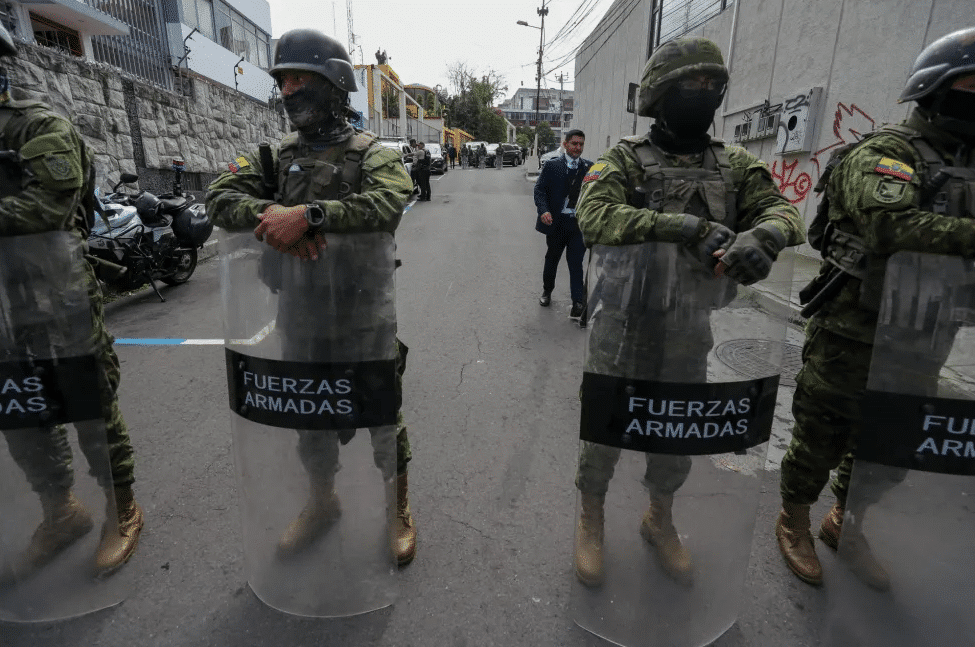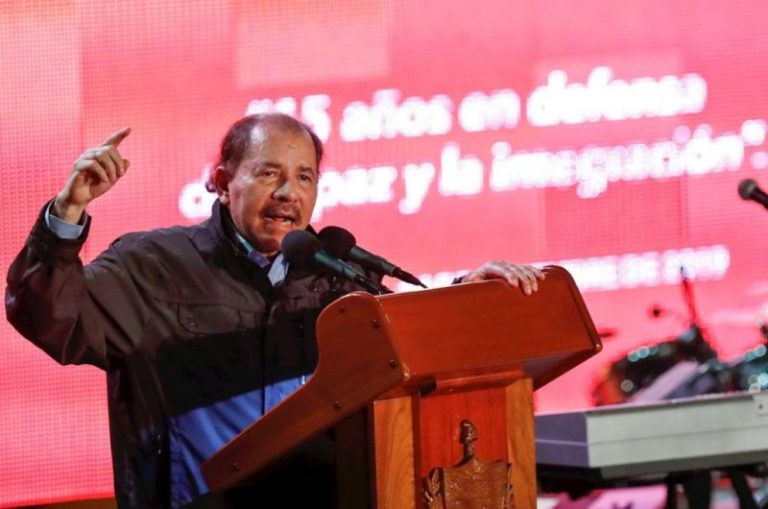27 de enero 2020

The Return of the Military

PUBLICIDAD 1M
PUBLICIDAD 4D
PUBLICIDAD 5D
Ortega is an agrarian patriarch. He may be the last cacique of that species. Reflections from a Central America that is ever less agrarian

diminished by the departures of Ecuador and Bolivia
The Somoza dictatorship was a Sultanate, stated sociologist Edelberto Torres-Rivas. Somoza was the government system. Once the Sultan was deposed from his throne, the whole structure came down like a house of cards.
But Somoza wasn’t the political culture, or machismo, merely their most visible representative – a strongman whose wishes are orders and his whims the law. When he left, nine strongmen replaced him.
No one within the Sandinista ranks questioned the fact that those nine weren’t even remotely representative of the national gender balance, despite the many risks taken and losses suffered by Nicaraguan women in the war. If they did question at all, they spoke with their lips pressed tightly together out of fear, discipline and dissimulation. Nor was there anyone counseling them to suppress that slogan: “National Directorate, [give us your] orders.”
The faces changed and the system continued, referring to the system of the strongman, the patriarch, the one that could declare, “I am the State”; or not say it, but merely behave that way. It’s a system tied to the Central America of agrarian republics that could be called agrarian autarchies. That system didn’t change one iota, even when Nicaragua became the first country on the Central American isthmus to elect a woman [Violeta Barrios de Chamorro, 1990 – 1997]. The accustomed faces soon returned: agricultural producer Arnoldo Aleman rose out of the Managua mayor’s office to become president, with the plan, but not the means, to perpetuate himself in power, as Somoza had done and as Ortega would do later.
Daniel Ortega invited him to a hacienda owners’ negotiation, as the bosses of Nicaragua’s two large parties, and there they closed a deal. Aleman sold his political birthright for a pair of jumbo nacatamales, and Ortega obtained the conditions he needed to recover the throne, one that in this second coming he didn’t have to share with other comandantes. The remaining leaders of finance, trade and plantations didn’t raise a fuss. That passivity – in addition to the obvious economic convenience – also revealed their tolerance about the executive power being assumed by someone who had been accused of sexually abusing his stepdaughter, and who proceeded to hang the red and black flag on all state offices. Their inclination to let slide all these “minor” problems stems from the widespread acceptance of cultural features that have been reproduced for centuries.
Ortega is a cacique, a chief, and an agrarian patriarch. His paramilitary, the military and the police have given us a very precise idea of what that cacique understands to be the art of governing.
A cultural genealogy could be traced to unite armed strongmen in Latin America, from Santa Ana to Trujillo, Castro and Pinochet – some in cahoots with the gringos, others against them, but all with arms and the will to drown any dissidence in blood. To them, then and now, politics must be a reflection of the hacienda’s chain of command, where the orders aren’t to be negotiated or discussed.
They’ve all been representatives of an agrarian patriarchy. Based on his political focus and his recent options, it’s clear that Ortega continues with that agrarian perspective, despite the fact that he came to power on the back of a party that has had a mostly urban base. He harvested his support in the cities, when many of us thought that the organization would head up a social advance, understood as a more egalitarian society.
In his return to power, his platform was a socialism constructed from funneling off and selling the Venezuelan oil. That golden stream was in large part channeled into the swimming pools of agrarian dreams: the Zero Hunger program and its distribution of diverse types of livestock and agricultural inputs and credit; agricultural fairs, so that the producers, highly subsidized by the state, could deal directly with consumers; the construction of rural schools, without training the teachers who would infuse them with scholastic life.
Symptomatic of the agrarian focus is the fact that the repression, from the time of the April rebellion to the present, has fattened itself on the rural areas. This occurs because the repressive organs are living in the agrarian Nicaragua of 1980, when the 1.6 million inhabitants in the cities represented barely half of the population. This is no longer true in the Nicaragua of 2018, whose nearly four million city dwellers are now 60% of the population. The FSLN represents a conservatism that’s not pro-farmer, in fact it’s anti-farmer, but is that of an agro-patriarchal nation-state, that of the large hacienda.
For that reason, the protests of April 2018 were incubated and exploded in the cities, linked to problems that affect the urban population most: social security, whose coverage is overwhelmingly city-dwellers; taxes that squeeze the urban centers; the infringement of civil rights (freedom of expression, freedom of movement, clean elections) that are primarily exercised by the urban population.
The greatest protests were unleashed around the topic of social security and the pensioners. This is surprising, because in this country barely one-fifth of the economically active population are covered by Social Security and the total coverage of seniors must be even less. But over 90% of those who contribute live in the cities, and that’s where the uprising broke out. Also, more than 90% of the university students, who were the leaders of the rebellion, are from the urban area. The initial flash point that ignited the civic insurrection – the protest against the Social Security Institute – was essentially a demand of those from the major cities where the struggle would later play out.
The rural population have also played a considerable role. They rose up [stating in 2013] when the project to build an inter-oceanic canal threatened to absorb their small and medium farms. That’s when the dichotomy of farmers versus the agrarian patriarchy came into view. Up until now, and maybe for all times, the canal has been the last Nicaraguan utopia that places land ownership as the pivot of accumulation.
It’s the last agrarian utopia to be conceived in a country where cattle, coffee growing and mining continue to be the principal industries that generate foreign exchange. If we look at the distinction that social scientist William Robinson makes between the extensive and the intensive expansion of capitalism, we can see that Ortega’s model, and that of his predecessors, places his bets on extensive expansion: with the canal, the urban constructions and lots, forest exploitation, and many other branches. That hoarding is tied to the violence that at times the medium ranchers wield in the indigenous lands, and the violence on a national level that the upper echelons of the army and the police organize. It’s no coincidence that Honduras and Nicaragua, the most agrarian and least urbanized countries, are the principal regional scenarios of looting and hoarding by brute force.
In the Central American countries that are more advanced in the process of urbanization, such as Panama, Costa Rica and El Salvador, the capital expansion is generally realized more intensively, incorporating goods and people into the marketplace by monetarizing things that previously weren’t on the market: landscapes whose beauty can be rented to tourists; family remittances that are banked; sale of services that before were exchanged or provided by family members and friends, etc.
But despite the fact that Nicaragua is a country where the agrarian patriarchy is calling the shots, the trend towards urbanization is already obvious. The value of family remittances, which are a monumental source of non-agrarian income, is well beyond any of the agricultural exports (and, of course, of the non-agrarian exports as well). The increasing weight of these remittances in the economy is the result of a globalized labor force from outside the agricultural area which has sustained the internal growth of business and services. This economic shrinking of the agrarian sphere has political expressions that have flowered in this rebellion.
In the case of two of the women leaders, Francisca Ramirez and Irlanda Jerez, the country and the city are hand in hand. However, both are businesswomen, although one is an agricultural producer and the other a dentist. With the exception of Medardo Mairena, who represents the farmers opposed to the great takeover of agrarian property under the disguise of a canal, the most visible men in the opposition are from the cities.
Juan Sebastian Chamorro and Felix Maradiaga, for example, appear to be the opposite of Ortega. They aren’t men of arms or ranches, but of an above-average educational level. They face off against a couple who are high school graduates and who have their roots in a Nicaragua where people made a place for themselves in the public sector via their last names or their pistols, not by their diplomas and educational level.
The crisis of Ortega’s regime reflects an imbalance in the cultural and political structures of that ancient agrarian patriarchy. The good news is that it’s impossible to plant yourself in front of the train of changing trends without being run over. All resistance to change only complicates it and prolongs the agony of the institutions, groups and persons that oppose it. It may be that the patriarchal dinosaur will continue on for a while; but we can be certain that the climatic conditions will soon make their lives unsustainable.
The bad news is that the process of transition that began decades ago and accelerated with the globalization will take an unforeseeable length of time and could generate much violence if adequate measures aren’t taken. A comparison with countries in the north of Central America can shed some light on that less agrarian Nicaragua that hasn’t finished being born, and on its consequences to the political system.
Archivado como:
PUBLICIDAD 3M
Escribió en CONFIDENCIAL entre 2026-2021. Doctor en Sociología por la Philipps Universität de Marburg (Alemania). Se desempeñó como investigador asociado en la Universidad Centroamericana José Simeón Cañas y del Instituto Brooks para la Pobreza Mundial de la Universidad de Manchester. Fue director del Servicio Jesuita para Migrantes en Nicaragua.
PUBLICIDAD 3D